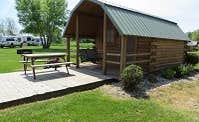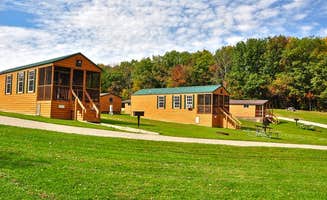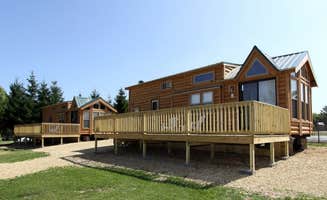Glamping near Menomonee Falls, Wisconsin offers alternatives to traditional camping with canvas accommodations, cabin-style structures, and enhanced outdoor experiences within a 60-mile radius. Located in southeastern Wisconsin's glacial terrain, these sites typically maintain accessibility throughout three seasons, though winter camping options are limited to a few locations. Temperatures during camping season average between 45-85°F, with July and August bringing the most consistent conditions for outdoor stays.
What to do
Water activities at Ottawa Lake: The clean, clear lake at Ottawa Lake Campground provides swimming, fishing and paddling opportunities in summer months. According to one visitor, "The lake is very clean and the site are a good size. Gets very busy on the weekends!" Water temperatures remain comfortable from mid-June through early September.
Beach access and swimming: Kohler-Andrae State Park features direct Lake Michigan beach access with swimming areas. A camper noted, "Beautiful state park right on Lake Michigan. Sunrises so, so beautiful. This campground has everything! Trails, dunes, marshes, forests, and Lake Michigan. Very well kept." The beach areas include designated swimming sections with gradually sloping sandy bottoms.
Wildlife observation: Bird watching opportunities abound throughout the region's parks, particularly at The Playful Goose Campground. One visitor shared, "Great sites along the Rock River, just a few minutes from the Horicon Marsh. Bird watching was abundant!" Spring and fall migrations offer peak viewing times with over 200 bird species documented in the area.
What campers like
Easy hiking trails: The terrain surrounding Menomonee Park features gentle elevation changes ideal for family hikes. A regular visitor mentioned, "There are miles of nice hiking trails, a nice beach, pavilions to rent, horse riding trails, archery range and I'm sure I'm missing more." Most trails range from 1-3 miles with clear markings.
Winter camping options: Several locations maintain year-round availability, including Ottawa Lake Campground. As one winter camper reported, "No showers in winter but awesome." Winter camping requires additional preparation with temperatures frequently dropping below 20°F between December and February.
Spacious, wooded sites: Naga-Waukee Park offers tree cover and vegetation between many sites. A camper described it as "A very nice, woodsy campground. Feels like you are further north than you really are!" Site sizes average 35-40 feet with moderate privacy screening from surrounding vegetation.
What you should know
Weekend crowding: Ottawa Lake Campground experiences significant weekend traffic during peak season. One visitor reported, "The campground was really busy during the weekend, but cleared out Sunday and we nearly had the whole loop to ourselves during the week." Weekday reservations typically remain available even during summer months.
Noise concerns: Big Foot Beach State Park camping areas can experience road noise from nearby highways. A camper noted, "More of a yard style, open camping. No privacy. Lots of kids everywhere." Traffic sounds remain present throughout day and night hours at certain sites.
Reservation requirements: Most glamping locations require advance booking, with reservations opening 11 months in advance for Wisconsin state parks. Electrical sites fill quickly, especially for summer weekends and holidays. Non-reservable sites operate on first-come, first-served basis with arrival recommended before noon on Fridays.
Tips for camping with families
Playground access: Honeysuckle Hollow Camping Area provides multiple play structures near camping areas. A family camper recommended, "We chose the loop 11 was on because it was close to the path to the playgrounds and lakes plus bathrooms... avoid the first 2 sites from either end as the ones closest to the main loop aren't very deep." Most playgrounds accommodate children ages 3-12.
Kid-friendly beaches: Menomonee Park offers a supervised swimming area with lifeguards during summer months. According to one reviewer, "The quarry is good for swimming, kayaking, or canoeing. There is a beach with life guards." The swimming area features a gradual entry and roped swimming sections with water depths to 12 feet.
Wildlife awareness: Ticks and mosquitoes require preparation, especially with young children. A parent advised, "SO many ticks. With a baby crawling that needed to be set free, we were constantly doing checks. Luckily our screen house pop up on a tarp that was sprayed ahead for tick repellent plus a blanket on top of that did the trick." Insect activity peaks from May through September.
Tips from RVers
Electric site considerations: Jellystone Caledonia provides full hookup options though at premium rates. One RVer noted, "Sites are medium sized. We had full hookup which was nice. Plenty of things to keep kids busy." Electric sites typically accommodate rigs up to 40 feet with some locations offering 50-amp service.
Dump station access: Most campgrounds provide dump stations, though wait times can be significant during peak checkout periods. A visitor reported, "The dump station was near the entrance to the camping loop and had potable water. It was also very busy and we had to wait when filling up and again when dumping." Dump stations typically operate from 8am to 8pm daily.
Site selection strategy: When glamping with larger RVs, site selection becomes crucial. An experienced camper suggested, "Recommend sites 23 to 46 for spacing and electric distance. We originally booked 96 but could not extend our slide because of large trees on either side of the pad." Reservation systems often include site dimensions and access notes to help with selection.




